When you take a holiday in Slovakia, it is quite normal to feel uncertain the first time you step into a town that you have never visited before. All around you are unfamiliar people, streets and buildings and you don’t know where to go. We promise that when you come to Žilina, we will make sure you have the information you need to give you confidence. And if you do feel lost, the Tourist Information Office in Žilina will be happy to help you. Whether you arrive by train, bus, car or plane, in winter or in summer, you will always be welcome here.

Žilina is the metropolis of north-west Slovakia, a town at the confluence of three rivers – the Váh, Kysuca and Rajčianka. It is the fourth largest town in Slovakia, the capital of the Žilina Self-Governing Region and the gateway to the Malá Fatra Region. Žilina is currently experiencing dynamic growth thanks to investments by KIA Motors Slovakia. The town is not just a centre for automotive manufacturing, it is also a tourist attraction both in its own right and in combination with the Malá Fatra region. It is the seat of Žilina University and, since 2008, of the Žilina Diocese. There has recently been a growth in interest in seminar and conference tourism in the town.
One of the main reasons to visit the Malá Fatra region is its rich history and culture. There is not one place that doesn’t have at least a short historical story attached to it. The gateway to the region – the town of Žilina – is a place that rightly deserves a visit. But did you know that the national premiere of the first ever film dramatizing the life of Jánošík took place in Žilina? There is an exhibition on the life of Slovakia’s most famous outlaw in the village of Terchová. If you travel to Kysuce, don’t forget to visit the only Slovak astronomical clock at Stará Bystrica, which is the most accurate in the world. The towns and villages of the region also have a rich cultural life. Every year, nearly everyone looks forward to the legendary Jánošíkove dni (Jánošík Days) festival in Terchová, the Staromestské dni (Old Town Days) in Žilina or the interesting events that bring to life Strečno Castle, the open-air museum at Vychylovka and Budatín Castle.
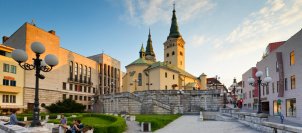
The historic centre of Žilina
Historic buildings, many cosy cafés and restaurants, the small shops lining one of the longest pedestrian zones in Slovakia – this is Žilina town centre. When strolling around the town, take time to enjoy the Andrej Hlinka Square and the Mariánske Square, which has been declared a Town Conservation Reservation. This has the largest density of historic buildings reflecting the history of the town. Stop and spend some time in each of them.
Andrej Hlinka Square
The Andrej Hlinka Square was once the channel of the River Váh, until the townspeople redirected it to make new land for fields. Later it was tiled over and became a square where eight roads meet. In the past, the brook Všivák flowed through the square but it has been covered over.
The Church of the Most Holy Trinity (Cathedral Church)
Appearing on nearly every postcard of Žilina, it has become the town’s unofficial symbol. If you miss the Holy Trinity church, you might as well not have been in Žilina. It began as a Gothic church but after reconstruction it now shows mainly a Renaissance style. The free-standing bell tower known as Burian’s Tower offers a beautiful bird’-eye view of the town centre.
Our tip: Take a photo of the Church of the Most Holy Trinity from Hlinka Square and take home a souvenir with the most characteristic view of the centre of Žilina.
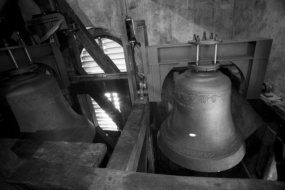
Burian’s Tower
In the past it served as a belfry, an observatory and helped protect the town against fires and enemies. Nowadays it is visited by dozens of tourists a day. The bell tower built in the style of an Italian campanile, separate from the church, is one of the main attractions in Žilina.
Look-out tower
It acquired a viewing terrace during its last reconstruction in 1941 and the public have been able to use it since 2013. The tower was opened to the general public to the sound of the renovated bells.
Inside the tower, visitors can see the restored bells, an exhibition of historical maps of Žilina and a unique 3D model of the town as it looked in 1933. The main reason to visit Burian’s Tower is the view that you reach by climbing the simple spiral staircase.
The Building of the Povazie Art Gallery
The Povazie Art Gallery is based in one of Žilina’s Secessionist buildings on Hlinka Square. The gallery presents new media alongside traditional painting, sculpture and drawing.
Babušek (Makovický) House
This is a building that captures tourists’ interest on first sight. It was once the workplace of Dr Dušan Petrovič Makovický, who was personal physician to the Russian writer L. N. Tolstoy. It is now the office of the Regional Cultural Centre and the Povazie Observatory in Žilina.

Mariánske Square
Mariánske Square, which means St. Mary’s Square, is often referred to as the historical heart of Žilina and it is certainly another spot that you need to visit. In its long history, the square has had many names reflecting changes in its function or in national politics.
Did you know that the buildings in the square were not always level with each other but that some stood forward? The facades were lined up when the arcades were built in 1521, after a great fire had destroyed a large part of Žilina.
The Žilina arcades
One of the distinctive features of Mariánske Square is the system of open vaulted arcades that the locals call “laubne” (from “podlubia” meaning “vaults”) They not only surround the square but extend to the adjoining Hodžová and Radničná Streets. There are similar arcades in other Slovak towns but there is nothing as extensive as in Žilina in any town in Slovakia and allegedly in all the former Kingdom of Hungary. What were they used for? The square was regularly used for fairs and markets. The owners of the houses, who were usually the richest traders and merchants in the town, would set up stalls under the arcades.
The first written record of Žilina dates from 1208. Tomáš, the head of Nitra County, refers to it in a letter as “Terra de Selinan” (the land of Žilina). The oldest architectural heritage monument in the town is to be found in the outer district of Dolné Rudiny – the Church of St. Stephen the King, which is in fact the oldest building of its kind in north-west Slovakia, with parts that can be traced to the 13th century. In 2008 the town celebrated the 800th anniversary of the first written reference to its territory. In 2012 the town celebrated the 700th anniversary of the first written reference to Žilina as a town. The historical heart of Žilina centred on Mariánske Square was declared a Town Conservation Reservation in 1987. The square’s quadrilateral plan and surrounding arcades give it an unmistakable atmosphere that is unique in Slovakia. The unofficial symbol of the town is the view from Hlinka Square to the Church of the Most Holy Trinity (the Cathedral Church) and the balustrades decorating the hill.
The statue they wanted to ban
The focal feature of the square (though not at its geometric centre) is a Baroque statue of the Immaculate Conception of the Virgin Mary with a relief of St. Florian on its base. The statue had to be repaired several times and in 1953 there was even a plan to take it away to another location. The legend is that the plan was abandoned after a stonemason fell from scaffolding and died.
Legends linked to the square
There are two wells on the square, one with a depth of 12.7 m in front of the building known as Panský dom (House of the Nobility), and the second with a depth of 10.4 m on the opposite side of the square. A pillory where criminals were exposed to shame used to stand next to one of the wells. There are a lot of legends about the square and how the buildings were linked by underground passages. Some people have even claimed that a tunnel was built all the way to Budatín Castle.
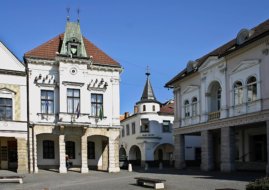
The old town hall
One of the buildings on Marianské Square that deserves individual attention is the old town hall. It began life as a Gothic building but has been modified many times. There is a legend that there used to a be a bell on the pinnacle of the town hall that was rung whenever a condemned prisoner was taken for execution on the Gallows Hill. Besides being the seat of the town’s administration, the building held the offices of the night watch, a prison and the town archive. The old town hall is now an office used by the mayor for ceremonial functions and on the ground floor there is a hall for civil weddings. Did you know that a carillon was installed on the building in 1994? You can hear it play every hour on the hour.
Church of the Conversion of St. Paul the Apostle and Monastery
The church was built with a single nave by Jesuits. It has three storeys and two towers. The Gothic cellars under the church are very interesting and many stories have become attached to them.
Žilina’s catacombs
They began as a place to inter dead bodies, then they were used to store food, later to hide Jewish children to save them from being deported to concentration camps in the Second World War and now they are a tourist attraction. The size and the mysterious atmosphere of the catacombs beneath Mariánske Square in Žilina are breath-taking. Until recently very few people knew what was hidden under the Church of the Conversion of St. Paul the Apostle on Mariánske Square in Žilina.
The cellars are surprising in their extent and many branches. Any tour is accompanied by a constant feeling of unease. Take a torch or headlamp with you. Walk through the dark and damp original passages. The dank air is illuminated here and there by light from air shafts. Some of the side passages have been blocked off and nobody knows what is behind them. The cellar walls were originally made from stones and wooden panels, but the latter were destroyed in one of the many fires that have affected Žilina.
Agatha’s legend
There are many tales and legends associated with the catacombs. One of them tells how, once upon a time, there was a wise woman called Agatha that many people in Žilina were afraid of because her prophecies very often came true. One day there was particularly bad weather, and Agatha wanted to take shelter. None of the houses on Mariánske Square would open their doors to her except the Jesuit brothers at their church. They let Agatha use one of the rooms in their Gothic cellars – the catacombs. It was just then that a great fire broke out and destroyed all the houses on Mariánske Square apart from the church and the monastery. People said that it was the desire for revenge and Agatha’s magic that caused the accident.
Take a tour with bated breath and a candle in hand through the dark passageways extending under Mariánske Square. Adventure awaits!
Fatra House of Arts (Grand Bio Universum)
This Secessionist building served as a cinema and theatre under the name “Grand Bio Universum” and in 1922 it hosted the national premiere of the first Slovak drama film Jánošík. It is now the seat of the Slovak Sinfonietta Žilina, a chamber orchestra.
Neolog Synagogue
One of the main landmarks in any tour of Jewish Žilina. The combination of functionalist architecture with Moorish elements makes the synagogue a unique heritage monument in Slovakia. The building underwent significant reconstruction in the years 2016–2017. It is now a venue for meetings, markets and thematic exhibitions.
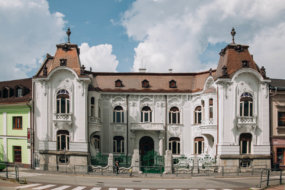
Rosenfeld Palace
Does the Rosenfeld Palace remind you of another famous building? If you guessed that it was a miniature replica of Vienna’s Belevedere Palace, you would be right. The Rosenfeld Palace is one of the most beautiful Secessionist buildings, not only in Žilina, but in all Slovakia. It has now been inscribed in the list of national cultural heritage monuments of Slovakia and it has become a new cultural centre for the town of Žilina. It is a place where people can attend various lectures, concerts, creative activities and workshops.
Second World War bunkers
Something you don’t see every day! The Malá Fatra region offers you the chance to look into authentic bunkers built in the Second World War. You can see them along the left bank of the River Bystrica at Krásno nad Kysucou and Zborov nad Bystricou. The best way to see them is to take a bicycle and ride along the Bystrica Cycle Path, which will take you straight to these historical curiosities. The bunkers date from the period of the liberation of German-occupied Krásno nad Kysucou at the end of the war. The Germans built the fortifications to cover their retreat from upper Orava through the Bystrica valley. The following information will be of interest to male visitors – the bunkers were equipped with MG 34 and MG 42 machine guns.
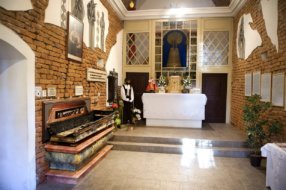
The Loretto Chapel of Žofia Bosniaková
The Loreto Chapel of Žofia Bosniaková is in Teplička nad Váhom. You can call visit this village when travelling from Žilina to Terchová. Žofia Bosniaková is one of the most famous names in the history of Teplička nad Váhom. Stop here on your holiday and learn about the story of this exceptional woman.
The saint of Strečno and the Bosniak roll
With the consent of her husband, Žofia Bosniaková opened a refuge in Teplička nad Váhom that gave shelter to the poor and abandoned, orphans and foreigners regardless of origin or affiliation. She gave the poor people small loaves of bread that became known as “bosniaks”. To this day “bosniak”, derived from the name of Žofia Bosniaková, is used to refer to small savoury buns in our part of the world.
Žofia never turned down any request for help. Her life was characterised by generosity, self-sacrifice and love for those less fortunate than herself. She died at Strečno Castle, where her body was found intact after 45 years, when new owners opened the crypt. It is a mystery how her body could remain incorrupt for so long when it was never embalmed.
Loreto Chapel
The chapel is named after the Italian pilgrimage town of Loreto. It is dedicated to the Blessed Virgin Mary of Loreto. The incorrupt body of Žofia Bosniaková was moved here from the church crypt in 1729. Her body remained here under a painting of her until 2009 when it was destroyed in a fire. Žofia’s remains were then transferred to a special box and returned to the chapel, which remains open to the public.
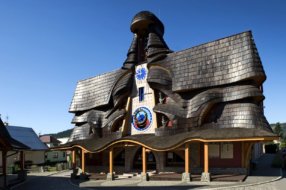
The Slovak astronomical clock in Stará Bystrica
Why go outside Slovakia? Did you know that you can admire an astronomical clock in our country? The Kysuce village of Stará Bystrica offers a treasure, the likes of which cannot be found anywhere else in the world. It holds several records such as being the most accurate astronomical clock in the world and the only one in Slovakia.
The largest wooden sculpture
The overall composition of the astronomical clock represents a seated figure of the Blessed Virgin Mary of the Seven Sorrows, one of Slovakia’s patron saints. It is shaped from wooden tiles held in place by an 80-piece timber framework.
Pribina with a sword
In alcoves around the astronomical clock there are six bronze busts. Can you name any of these famous Slovaks? Visitors are under the gaze of Prince Pribina, King Svätopluk, Anton Bernolák, Ľudovít Štúr, Milan Rastislav Štefánik and Andrej Hlinka. It is interesting that Pribina is shown with a sword and Svätopluk appears with a crown as the king of the early Slovaks. All six busts were cast in bronze.
The heart of the astronomical clock
The most significant part of an astronomical clock is the astrolabe, a means of displaying astronomical information. It is the astrolabe that gives Stará Bystrica the first and only astronomical clock in Slovakia. Without it, it would just be an ordinary clock. The colours of the main panel of the astrolabe represent the stages of the daily cycle: black for night, red for sunrise, light blue for the day and red again for sunset. A hand with the sun moves around these fields based on the current location of the sun. The main panel of the astrolabe is further divided by golden edging indicating the Equator, Tropic of Cancer, Tropic of Capricorn and the local meridian, which is the segment of the line showing when the sun reaches the highest point in the sky over Stará Bystrica
Gallery and information centre
There are two bells in the astronomical clock’s turret. One bell tolls the hours while the other provides a background for the promenade of the apostles. In the room under the astronomical clock there is an art information centre. It has a small gallery that sells the work of professional and amateur artists.
Our tip: Wait for the astronomical clock to chime the hour. Observe with bated breath as the apostles go by to the sound of the bells while an audio commentary tells the story of the Slovak astronomical clock. We are sure that you will remember this experience for a long time, and you may want to wait another hour to see the show again.
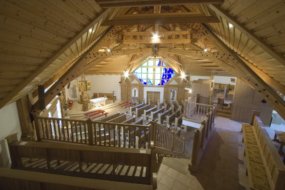
The Church of St. Andrej Svorad and St. Benadik in Radôstka
Radôstka is a picturesque village in a beautiful setting in the Kysuce Highlands. However, what people most often photograph here is not the beautiful landscape. It is the Roman Catholic Church of St. Andrej Svorad and St. Benadik. Visit Radôstka during your holiday in the Malá Fatra region and we can guarantee that you will also want a photograph of it.
A small village with a big award
Not every village in Slovakia can boast that they have an award-winning church. Radôstka has one, and they are rightfully proud of their church. The European Institute of Cultural Routes, based in Luxembourg, awarded the design of the interior of the Church of St. Andrej Svorad and St. Benadik second place for rural architecture in eastern Europe. This should make it clear why the church gets photographed so often.
Modern but traditional at the same time
The church is made of wood. It appears modern but it preserves traditional Kysuce building techniques and fits beautifully into the mountainous landscape. The overall design of the building and the natural materials used are in harmony with the characteristics of the region. The wood for the construction of the church was donated by local residents. A tall belfry and a rectory are attached to the church. Unlike other recently built churches, this building shows real sensitivity in its use of stone and wood. The interior incorporating elements of folk architecture is certainly worth a visit. Hearing mass in this magnificent space is an outstanding experience.
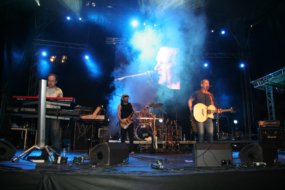
Events bring Žilina to life
The town centre has one of the longest and most beautiful pedestrian zones in Slovakia with many restaurants and stylish cafés. Throughout the year the town hosts many cultural, sports and social events including the Old Town Festival, the Žilina Literary Festival, Kiosk, the Medieval Day and many others. If you cannot take in all the beauties of Žilina in a single day, there is no need to worry. Right in the centre you can stay in the one hotel in the Žilina Region that has earned the description “boutique”. It offers an exclusive environment created by combining incomparable design, decent luxury and an intimate atmosphere. The hotel is also popular for the creative gastronomic experiences it offers. Have an unforgettable romantic dinner and then relax in the hotel’s Relax Centre. If you prefer more active relaxation, you certainly won’t regret a visit to the beach sport area “NA LEGENDÁCH”.
Subscribe to our newsletter and it will be our pleasure to send you the best tips, offers and events that make our region worth visiting.